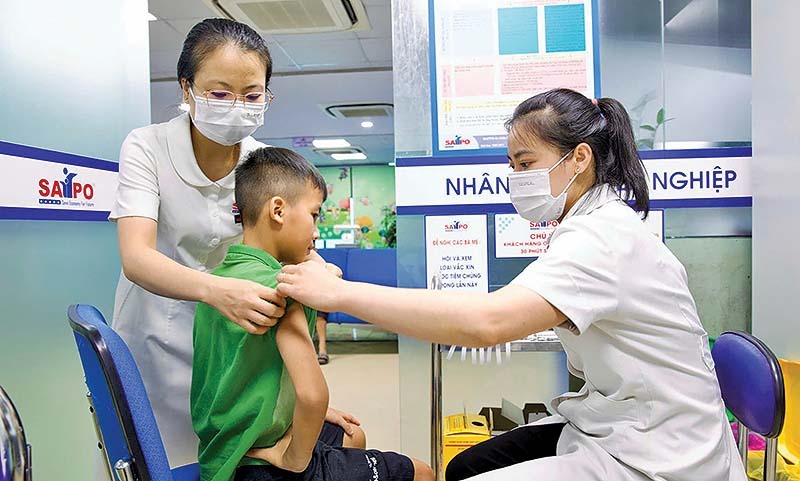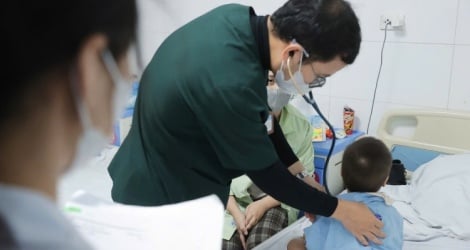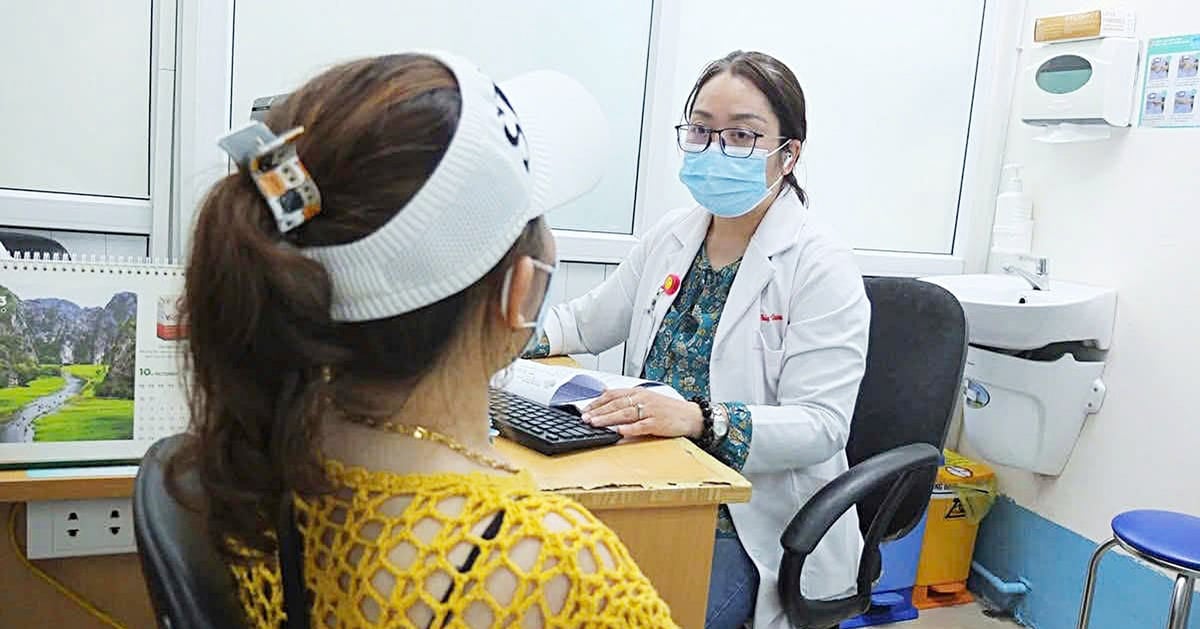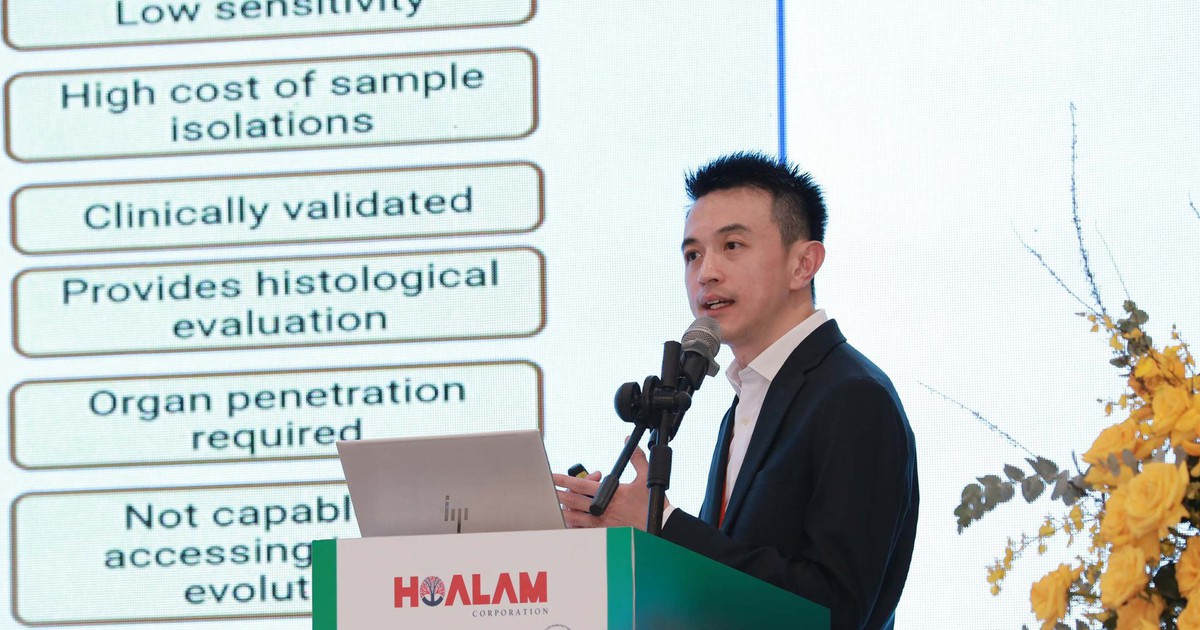According to the Hanoi Center for Disease Control (CDC), the number of measles cases has been increasing in the past two months.
Health news on December 4: Hanoi proactively takes measures to prevent and control measles
According to the Hanoi Center for Disease Control (CDC), the number of measles cases has been increasing in the past two months.
Take proactive measures to prevent and control measles
During the past week from November 22 to November 28, the city recorded 25 cases of measles, of which 23 cases had not been vaccinated against measles, 2 cases had been vaccinated against measles. The cumulative number of measles cases in 2024 was 140 cases, with patients recorded in 26 districts in the city.
Worryingly, most of the patients were unvaccinated or had not received two doses of the vaccine. Specifically, by age group, there were 43 cases under 9 months (30.7%), 21 cases 9-11 months (15%), 23 cases 12-24 months (16.4%), 19 cases 25-60 months (13.6%), and 34 cases over 60 months (24.3%).
Nearly 40% of cases are related to the possibility of measles infection in hospitals when examining and treating other diseases. Hanoi CDC believes that cases will continue to be recorded in the last month of 2024 and the first 3 months of 2025.
 |
| Measles vaccination is an important measure to prevent and control epidemics. |
Epidemiological analysis results show that most patients with the disease have not been vaccinated, or have not received 2 full doses of the vaccine.
Faced with the above situation, the Hanoi Health sector has synchronized measures to effectively prevent and control the disease.
Hanoi CDC coordinates with District, Town and City Health Centers to organize a measles-rubella vaccination campaign for children aged 1-5 years old and medical staff at risk at medical examination and treatment facilities treating measles patients.
Accordingly, since October 14, the entire city has launched a measles-rubella vaccination campaign for children aged 1-5 and medical staff at risk at medical examination and treatment facilities treating measles patients.
The results showed that the entire city had screened 61,590 children who had not received 2 doses of measles-containing vaccine, and 3,813 children who had received a live attenuated vaccine within 1 month before the campaign (subjects for temporary postponement of vaccination).
Thus, the total number of children aged 1-5 years old who are eligible for the 2024 campaign is 57,777. For health workers, the total number of health workers who have not received 2 doses of measles vaccine and are eligible for the campaign is 2,367.
As of November 15, 57,903 subjects have been vaccinated, of which 55,640 subjects are children aged 1-5 years old, reaching 96.3% of the total number of subjects subject to vaccination campaign; 2,263 subjects are medical staff, reaching 95.6% of the total number of subjects subject to vaccination campaign. At the same time, coordinate with medical centers to organize zoning, investigation, and handling of areas with recorded cases and measles outbreaks.
Along with professional activities, to improve the effectiveness of epidemic prevention and control, Hanoi CDC also coordinates with relevant units to strengthen communication activities on measles prevention and control; propagate the measles campaign to help people grasp the epidemic situation, the meaning of vaccination, on schedule and respond to participate in the campaign.
In order to proactively respond to the epidemic situation, in the coming time, Hanoi CDC will continue to synchronously deploy measures to prevent and control measles.
Advise and propose to the Hanoi Department of Health to direct medical facilities and hospitals that receive and treat measles patients to effectively control infections and prevent cross-infection in hospitals.
Direct private units conducting measles diagnostic tests in the city to fully report information on cases testing positive for measles to the Hanoi CDC or medical centers of districts, towns and cities in the area for coordination in investigation and handling.
In addition, Hanoi CDC also coordinates with units to promote communication on measles vaccination.
Two children poisoned after parents mistook daffodil leaves for chives
According to news from the National Children's Hospital, the hospital's Emergency and Poison Control Department has just treated a child who was poisoned after mistakenly eating daffodil leaves.
Previously, due to mistaking daffodil leaves for chives, the family of two children (2 years old) used them to cook porridge to treat cough. After eating, both children showed gastrointestinal symptoms such as stomachache and continuous vomiting. At this time, the family realized the mistake and immediately took the children to the hospital.
Doctor Bui Tien Cong, Department of Emergency and Poison Control (National Children's Hospital) said that here, the children were hospitalized to monitor their vital functions, and at the same time, measures were taken to eliminate toxins from the body by washing the stomach combined with the use of activated charcoal to absorb toxins and laxatives.
In addition, doctors also replenish water and electrolytes for children and perform tests to evaluate liver, kidney, and heart function to promptly detect complications.
Thanks to the active intervention of the medical team, after just over a day of treatment, the health of the two children stabilized and they were safely discharged from the hospital.
Narcissus is native to Europe, China, and Japan. Recently, this plant has been introduced to Vietnam. The plant belongs to the genus Narcissus, which includes about 40 species of tuberous plants, belonging to the family Amaryllidaceae.
Most daffodils are perennials, growing from bulbs in spring, flat leaves, plants are 20cm-1.6m tall depending on the species. The flowers are trumpet-shaped, yellow, white, pink with six petals and a central pistil. Daffodils have bulbs like onions, leaves like garlic leaves but thinner.
Although it is a beautiful ornamental plant, according to doctors, all parts of the narcissus plant are poisonous, especially the bulbs. The plant contains Lycorine, which causes symptoms such as vomiting, nausea, sweating, and slow heart rate.
Therefore, accidentally eating large quantities of daffodils can cause convulsions, circulatory and respiratory depression, and coma. In addition, daffodil bulbs contain oxalates, which can cause burns and irritation to the lips, tongue, and throat if swallowed.
Doctors recommend that daffodils have bulbs like onions and leaves similar to garlic and chives but thinner, so families should be careful with the elderly and children to avoid confusion like the case above.
Septic shock, multiple organ failure due to streptococcal infection during slaughter
The Department of Intensive Care and Anti-Poison, Ha Dong General Hospital has just received a 32-year-old male patient (residing in Chuong My, Hanoi), transferred from the grassroots medical facility to the hospital with a diagnosis of septic shock due to Streptococcus suis.
Dr. Tran Dinh Thang, Department of Intensive Care, said the patient performed pig slaughtering work on a pig that died of unknown causes. Five hours after the pig slaughter, the patient developed chills, fever, fatigue, abdominal pain, and vomiting.
The patient was admitted to the Department of Tropical Diseases for treatment in a state of fatigue, drowsiness, difficulty breathing, severe abdominal pain and continued vomiting.
Two hours later, the patient developed rapidly increasing necrotic hemorrhagic rash on the skin, accompanied by respiratory failure and hypotension. The patient was transferred to the Intensive Care Unit in critical condition.
When admitted to the Intensive Care Unit, the patient had generalized edema, multiple hemorrhagic necrosis rashes all over the body and on the face, multiple organ failure, liver and kidney damage, blood clotting disorders, etc.
The patient was diagnosed with septic shock due to Streptococcus suis. The patient was prescribed continuous blood filtration, high-dose broad-spectrum antibiotics and many other intensive procedures. Blood culture was positive for Streptococcus Suis.
During the treatment, the patient developed complications of septic shock, multiple organ failure, hemolysis, skin necrosis, etc. The patient was treated intensively for 21 days, his condition improved well and he was discharged from the hospital in the next few days. However, the patient was brought to the hospital late, leaving behind hearing loss.
According to Dr. CKII. Doan Binh Tinh - Head of the Intensive Care Department, recently, Ha Dong General Hospital received and treated cases of streptococcus suis infection, many patients were transferred to the hospital in very critical condition, multiple organ failure and severe blood clotting disorders. Some patients died due to being brought to the hospital late in a state of septic shock with severe multiple organ failure that could not be recovered. Some patients were cured but had to have their necrotic fingertips or toes amputated, with neurological sequelae...
Streptococcus suis is caused by the bacteria Streptococcus suis. Humans can become infected and develop the disease through direct contact with sick pigs or products from sick pigs.
Streptococcus suis can be transmitted to humans through contact with sick pigs or pigs carrying the bacteria through scratched lesions on the skin of people who slaughter, process or eat undercooked pork or blood pudding from sick pigs or pigs carrying the bacteria.
In humans, the most common manifestation is purulent meningitis (95%) with common symptoms such as fever, headache, vomiting, stiff neck, and impaired perception. 68% of cases of purulent meningitis have symptoms of tinnitus and deafness.
Severe cases can progress rapidly to septic shock, circulatory collapse, hypotension, severe coagulation disorders, hemorrhagic necrosis, embolism, multiple organ failure... coma and death.
To prevent Streptococcus suis, doctors recommend that people cook pork thoroughly. Do not slaughter sick pigs or pigs that have died of unknown causes, and do not eat raw dishes, especially pig blood pudding.
Use protective equipment (gloves) when slaughtering and processing raw pork. When exposed to sources of infection such as sick pigs or after eating food from unsanitary pigs and experiencing symptoms of the disease, you should immediately go to the nearest specialized medical facility for treatment to limit complications and reduce mortality.
Source: https://baodautu.vn/tin-moi-y-te-ngay-412-ha-noi-chu-dong-cac-bien-phap-phong-chong-dich-soi-d231633.html


![[Photo] Closing of the 11th Conference of the 13th Central Committee of the Communist Party of Vietnam](https://vstatic.vietnam.vn/vietnam/resource/IMAGE/2025/4/12/114b57fe6e9b4814a5ddfacf6dfe5b7f)



![[Photo] Overcoming all difficulties, speeding up construction progress of Hoa Binh Hydropower Plant Expansion Project](https://vstatic.vietnam.vn/vietnam/resource/IMAGE/2025/4/12/bff04b551e98484c84d74c8faa3526e0)








![[Video] First time in Vietnam: Successful implantation of 3rd generation partial artificial heart](https://vstatic.vietnam.vn/vietnam/resource/IMAGE/2025/4/12/8817412224094c68ba2c744b7bd5cfea)













































































Comment (0)